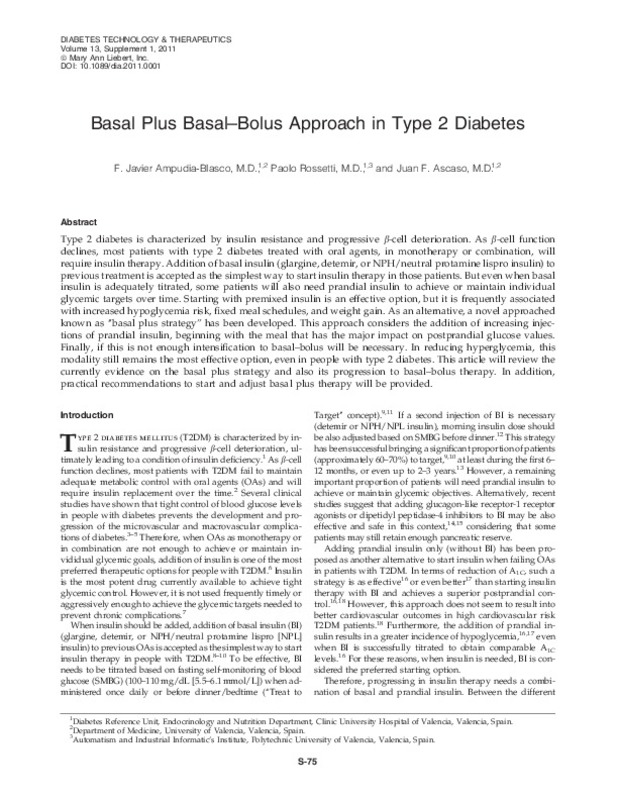JavaScript is disabled for your browser. Some features of this site may not work without it.
Buscar en RiuNet
Listar
Mi cuenta
Estadísticas
Ayuda RiuNet
Admin. UPV
Basal plus basal-bolus approach in type 2 diabetes
Mostrar el registro sencillo del ítem
Ficheros en el ítem
| dc.contributor.author | Ampudia-Blasco, Javier
|
es_ES |
| dc.contributor.author | Rossetti ., Paolo
|
es_ES |
| dc.contributor.author | Ascaso, Juan F.
|
es_ES |
| dc.date.accessioned | 2013-06-11T13:23:41Z | |
| dc.date.available | 2013-06-11T13:23:41Z | |
| dc.date.issued | 2011 | |
| dc.identifier.issn | 1520-9156 | |
| dc.identifier.uri | http://hdl.handle.net/10251/29638 | |
| dc.description | This is a copy of an article published in the Diabetes Technology and Therapeutics © 2011 [copyright Mary Ann Liebert, Inc.]; Diabetes Technology and Therapeutics is available online at: http://online.liebertpub.com. | |
| dc.description.abstract | [EN] Type 2 diabetes is characterized by insulin resistance and progressive b-cell deterioration. As b-cell function declines, most patients with type 2 diabetes treated with oral agents, in monotherapy or combination, will require insulin therapy. Addition of basal insulin (glargine, detemir, or NPH/neutral protamine lispro insulin) to previous treatment is accepted as the simplest way to start insulin therapy in those patients. But even when basal insulin is adequately titrated, some patients will also need prandial insulin to achieve or maintain individual glycemic targets over time. Starting with premixed insulin is an effective option, but it is frequently associated with increased hypoglycemia risk, ¿xed meal schedules, and weight gain. As an alternative, a novel approached known as ``basal plus strategy¿¿ has been developed. This approach considers the addition of increasing injections of prandial insulin, beginning with the meal that has the major impact on postprandial glucose values. Finally, if this is not enough intensi¿cation to basal¿bolus will be necessary. In reducing hyperglycemia, this modality still remains the most effective option, even in people with type 2 diabetes. This article will review the currently evidence on the basal plus strategy and also its progression to basal¿bolus therapy. In addition, practical recommendations to start and adjust basal plus therapy will be provided. | es_ES |
| dc.description.sponsorship | F.J.A.-B. has received honoraria as speaker and/or consultant from Abbott, AstraZeneca, Bristol-Myers Squibb, Glaxo-SmithKline, LifeScan, Lilly, Madaus, MannKind Corp., Medtronic, Menarini, Merch Farma y Quimica, SA, MSD, Novartis, Novo Nordisk, Pfizer, Roche, sanofi-aventis, Schering-Plough, and Solvay. In addition, F.J.A.-B. has participated in clinical trials supported totally or partially by AstraZeneca, Glaxo-SmithKline, LifeScan, Lilly, MSD, Novo Nordisk, Pfizer, sanofi-aventis, and Servier. P. R. has no potential conflicts of interest to declare. J.F.A. has received honoraria as speaker and/or consultant form AstraZeneca, Ferrer, Glaxo-SmithKline, Laboratorios Dr. Esteve, Lilly, MSD, and Solvay. | en_EN |
| dc.language | Inglés | es_ES |
| dc.publisher | Mary Ann Liebert | es_ES |
| dc.relation.ispartof | Diabetes Technology & Therapeutics | es_ES |
| dc.rights | Reserva de todos los derechos | es_ES |
| dc.title | Basal plus basal-bolus approach in type 2 diabetes | es_ES |
| dc.type | Artículo | es_ES |
| dc.identifier.doi | 10.1089/dia.2011.0001 | |
| dc.rights.accessRights | Abierto | es_ES |
| dc.contributor.affiliation | Universitat Politècnica de València. Instituto Universitario de Automática e Informática Industrial - Institut Universitari d'Automàtica i Informàtica Industrial | es_ES |
| dc.description.bibliographicCitation | Ampudia-Blasco, J.; Rossetti ., P.; Ascaso, JF. (2011). Basal plus basal-bolus approach in type 2 diabetes. Diabetes Technology & Therapeutics. 13:75-83. doi:10.1089/dia.2011.0001 | es_ES |
| dc.description.accrualMethod | S | es_ES |
| dc.relation.publisherversion | http://online.liebertpub.com/doi/pdf/10.1089/dia.2011.0001 | es_ES |
| dc.description.upvformatpinicio | 75 | es_ES |
| dc.description.upvformatpfin | 83 | es_ES |
| dc.type.version | info:eu-repo/semantics/publishedVersion | es_ES |
| dc.description.volume | 13 | es_ES |
| dc.relation.senia | 220422 |








